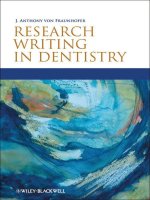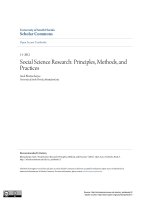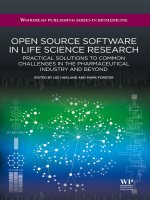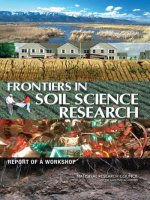Science research writing hilary glasman deal 2010
Bạn đang xem bản rút gọn của tài liệu. Xem và tải ngay bản đầy đủ của tài liệu tại đây (1.77 MB, 271 trang )
P605tp.indd 1
12/10/09 2:24:41 PM
This page intentionally left blank
Hilary Glasman-Deal
Imperial College London, UK
ICP
P605tp.indd 2
Imperial College Press
12/10/09 2:24:42 PM
Published by
Imperial College Press
57 Shelton Street
Covent Garden
London WC2H 9HE
Distributed by
World Scientific Publishing Co. Pte. Ltd.
5 Toh Tuck Link, Singapore 596224
USA office: 27 Warren Street, Suite 401-402, Hackensack, NJ 07601
UK office: 57 Shelton Street, Covent Garden, London WC2H 9HE
Library of Congress Cataloging-in-Publication Data
Glasman-Deal, Hilary.
Science research writing for non-native speakers of English / by Hilary Glasman-Deal.
p. cm.
Includes bibliographical references.
ISBN 978-1-84816-309-6 (alk. paper) -- ISBN 978-1-84816-310-2 (pbk : alk. paper)
1. English language--Technical English--Handbooks, manuals, etc. 2. Technical writing-Handbooks, manuals, etc. 3. English language--Textbooks for foreign speakers. I. Title.
PE1475.G57 2009
808'.0665--dc22
2009043016
British Library Cataloguing-in-Publication Data
A catalogue record for this book is available from the British Library.
Copyright © 2010 by Imperial College Press
All rights reserved. This book, or parts thereof, may not be reproduced in any form or by any means,
electronic or mechanical, including photocopying, recording or any information storage and retrieval
system now known or to be invented, without written permission from the Publisher.
For photocopying of material in this volume, please pay a copying fee through the Copyright
Clearance Center, Inc., 222 Rosewood Drive, Danvers, MA 01923, USA. In this case permission to
photocopy is not required from the publisher.
Printed in Singapore.
Kim - Science Research Writing.pmd
1
1/13/2010, 1:49 PM
FA
v
Introduction: How to Use This Book
Things should be made as simple as possible, but not any simpler.
— Albert Einstein
Who is this book for?
This book is designed to help non-native speakers of English write science
research papers for publication in English. However, it can also be used as a
guide for native English speakers who would like support with their science
writing, and by science students who need to write a Master’s dissertation or
PhD thesis. It is a practical, rather than a theoretical book, and is intended
as a fast do-it-yourself manual for researchers and scientists.
The book is aimed at those whose English language ability is at
intermediate level or above. If you have taken an IELTS test, this is
equivalent to a score of above 6.0; if you have taken a TOEFL test then
this is approximately equivalent to a score above 550 (paper-based test) or
91 (iBT). However, if you have managed to read this far without using a
dictionary, you will be able to use this book, even if you don’t understand
every word.
Why do I need it?
The goal of scientific research is publication, but good scientists are not
always good writers and even native speakers of English sometimes have
difficulty when they write up their research. The aim of this book is to give
you the information, vocabulary and skills you need quickly and easily so
that you can write confidently using the style and structure you see in the
journals you read.
B875_FM.indd v
12/11/2009 8:47:52 AM
FA
vi
Science Research Writing
As a science researcher, you are able to read and understand complex,
high-level material in your field. However, you may find it difficult to
produce written English which is at the same level as your reading. You
may feel that your English writing does not represent the content of your
work effectively or accurately. The aim of this book is to enable you to use
your reading ability and the material you read to develop the writing skills
your work requires.
Developing the skills to write up your own research is the only way to
join the international science community. If you depend on English speakers
to translate your writing, their translation may not represent exactly what
you intended. If you depend on proofreaders to correct your English they
may not notice some errors, because a sentence which is grammatically
correct is still ‘wrong’ if it does not mean what you intended. Also, a
proofreader may not check whether your writing fits the conventional
‘science research’ patterns. For example, you may have forgotten to justify
your choice of method or explain how your results relate to your original
question, and this could mean that an editor of a science journal rejects
your paper as unprofessional.
Writing and publishing a research paper is the best way to get your
career off the ground. If you can turn your thesis or research project into
a useful paper, your CV (Curriculum Vitae) will immediately look more
professional and will be more competitive internationally. You may feel
that you don’t have the time to improve your English, but you already
know most of what you need from the reading you have done over the
years. In order to write up your research for publication you don’t need to
learn much more English than you already know. Science writing is much
easier than it looks.
Most science research is written according to a fairly conventional
structure: first the title, then the abstract, followed by an introduction, after
which there is a central section which describes what was done and what
was found and then a discussion and/or conclusion. At the end of the paper
or research article, acknowledgements and references are added. This
means that the structure of a research article will be quite similar for all
writers.
Because science writing is so conventional, the amount of grammar
and vocabulary you need to learn is quite small. For example, the nontechnical vocabulary used in scientific writing consists of a limited set of
B875_FM.indd vi
12/11/2009 8:47:52 AM
FA
Introduction: How to Use This Book
vii
words such as attempt, conduct, interpret, evaluate, determine, implement,
formulate, classify, correlate, enhance, which are used as a kind of ‘code’.
All the vocabulary you need to get started (apart from the specialised
vocabulary of your field) is in this book.
What will this book teach me?
The book will show you how to discover the conventions of structure,
organisation, grammar and vocabulary in science writing in your field and
will provide you with the tools to write in a similar way and at a similar
level. It will teach you how to turn your research into a paper that can be
submitted to a professional journal. You will also be able to use most of the
information in the book and all of the language and vocabulary if you are
writing a thesis in English.
I have been teaching English for Academic Purposes to science students
for over 30 years. For the past 15 years I have been teaching research writing
in the English Language Support Programme at Imperial College, London,
where I also work closely with individual research students and staff who
are writing a paper or thesis. This book is based on the most useful thing
I have learned: when your language skills are not perfect, organising your
information in a conventional way and using conventional language are
very important. If you write according to a conventional model, the reader
knows what you are trying to do because the model you are following is
familiar, and language errors are therefore less significant. A researcher who
begins by writing according to a simple and conventional model will soon
develop higher level skills for writing independently and professionally. The
opposite is also true: researchers who do not begin by writing according to
a conventional model are less likely to develop these skills.
How does the book work?
The strategy in this book can be summed up as follows: carefully examine
good examples of the kind of writing you would like to produce, identify
and master the structure, grammar and vocabulary you see in these
examples and then apply them in your own writing.
The book is divided into five units, each dealing with one section of a
research article. Unit 1 deals with the Introduction, Unit 2 the Methodology,
Unit 3 the Results, Unit 4 the Discussion or Conclusion and Unit 5 the
B875_FM.indd vii
12/11/2009 8:47:52 AM
FA
viii
Science Research Writing
Abstract and Title. Since the aim of this book is to enable you to write
in a conventional way, each unit is designed to help you discover what
the conventional model of that section of a research article looks like. In
each unit you will also be given support on the grammar and writing skills
needed to write that section of the research article and you will be guided
towards the appropriate vocabulary.
Each unit is similar. The unit on Introductions, for example, begins by
looking at a sample research article Introduction similar to those in science
journals, then there is a Grammar and Writing Skills section designed to
respond to frequently asked questions. Because you are probably working
hard on your research and don’t have time to do much grammar work,
there are very few grammar exercises in the Grammar and Writing Skills
sections. In any case, getting the answer right in a grammar exercise doesn’t
automatically mean you will produce the correct grammar when you write
about complex topics. Answering correctly can give you a false sense of
confidence and security.
After the Grammar and Writing Skills section you will create a model
or template for writing Introductions using the sample Introduction, and
this is followed by a detailed Key providing model descriptors, discussion
and answers to questions. The unit includes extracts from real Introductions
so that you can test the model and see how it works in the ‘real world’. These
extracts are then used to find the vocabulary which will help you operate the
model successfully. This is followed by a complete list of useful vocabulary
together with examples of how the words and phrases are used.
At this stage, you will have a robust model of an Introduction, a
grammar guide to deal with possible problems and a list of useful vocabulary
to make the model work. Towards the end of the unit, you will be ready to
test what you have learned by writing an Introduction. If you have done
the tasks, you should be able to put the model, the grammar/writing skills
and the vocabulary together, and a perfect Introduction will write itself
almost automatically! So at the end of the unit on Introductions, you will
try out what you have learned: you will write an Introduction using the
model and the vocabulary list and then compare it with a sample answer
in the Key.
This pattern is repeated in the rest of the units. Ideally, you should
work through the book and do each task. If you read the book without
completing the tasks you will have an intellectual understanding of what to
do but you may find it harder to put it into practice.
B875_FM.indd viii
12/11/2009 8:47:52 AM
FA
Introduction: How to Use This Book
ix
Do I need any other material or books?
No, but before you begin, you should collect three or four recent research
papers in your field from the journals you usually read and photocopy
them. You will use these as target articles to help you adapt what you learn
here to your own work, and you will refer to them while reading this book
to see how the things you are learning are done in your research field. Don’t
use chapters from books as target articles; they are not written according to
the same conventional structure as research papers and so will not help you
discover how a research paper or thesis in your field is written.
Your target research articles should:
• be written by a researcher/research team based at an English-speaking
institution, ideally a native speaker of English.
• be reasonably short (less than 15 A4 sides including graphs and tables).
• deal with subject matter which is as close as possible to your own topic
and the kind of research you are doing.
• have clearly defined Introduction, Methodology, Results and Discussion/
Conclusion sections. It will help you if these are subtitled so that you can
locate them easily. Note that the subtitles may vary in different fields and
even in different journals in each field; for example the Methodology
can be called ‘Procedure’, ‘Materials and Methods’, ‘Experimental’ or
some other variation.
B875_FM.indd ix
12/11/2009 8:47:52 AM
FA
This page intentionally left blank
B875_FM.indd x
12/11/2009 8:47:52 AM
FA
xi
Contents
Introduction: How to Use This Book
v
Unit 1: How to Write an Introduction
1.1 Structure
1.2 Grammar and Writing Skills
1.2.1 Tense pairs
1.2.2 Signalling language
1.2.3 Passive/Active
1.3 Writing Task: Build a Model
1.3.1 Building a model
1.3.2 Key
1.3.3 The model
1.3.4 Testing the Model
1.4 Vocabulary
1.4.1 Vocabulary for the Introduction
1.5 Writing an Introduction
1.5.1 Write an Introduction
1.5.2 Key
1
4
4
7
11
15
15
17
24
25
32
34
41
41
42
Unit 2: Writing about Methodology
2.1 Structure
2.2 Grammar and Writing Skills
2.2.1 Passives and tense pairs
2.2.2 Use of ‘a’ and ‘the’
2.2.3 Adverbs and adverb location
2.3 Writing Task: Build a Model
2.3.1 Building a model
2.3.2 Key
B875_FM.indd xi
44
46
47
50
56
57
57
59
12/11/2009 8:47:52 AM
FA
xii
Science Research Writing
2.3.3 The model
2.3.4 Testing the model
2.4 Vocabulary
2.4.1 Vocabulary task
2.4.2 Vocabulary for the Methodology section
2.5 Writing a Methodology Section
2.5.1 Write a Methodology section
2.5.2 Key
66
67
75
76
77
88
88
90
Unit 3: Writing about Results
3.1 Structure
3.2 Grammar and Writing Skills
3.2.1 Sequence
3.2.2 Frequency
3.2.3 Quantity
3.2.4 Causality
3.3 Writing Task: Build a Model
3.3.1 Building a model
3.3.2 Key
3.3.3 The model
3.3.4 Testing the model
3.4 Vocabulary
3.4.1 Vocabulary task
3.4.2 Vocabulary for the Results section
3.5 Writing a Results Section
3.5.1 Write a Results section
3.5.2 Key
91
94
94
99
102
108
111
111
113
122
124
135
136
137
149
150
151
Unit 4: Writing the Discussion/Conclusion
4.1 Structure
4.2 Grammar and Writing Skills
4.3 Writing Task: Build a Model
4.3.1 Building a model
4.3.2 Key
4.3.3 The model
4.3.4 Testing the model
B875_FM.indd xii
154
158
167
167
170
179
180
12/11/2009 8:47:52 AM
FA
Contents
4.4 Vocabulary
4.4.1 Vocabulary task
4.4.2 Vocabulary for the Discussion/Conclusion
4.5 Writing a Discussion/Conclusion
4.5.1 Write a Discussion/Conclusion
xiii
186
187
187
193
194
Unit 5: Writing the Abstract
5.1 Structure
5.2 Grammar and Writing Skills
5.2.1 Verb tense
5.2.2 Length
5.2.3 Language
5.3 Writing Task: Build a Model
5.3.1 Building a model
5.3.2 Key
5.3.3 The models
5.3.4 Testing the models
5.4 Vocabulary
5.4.1 Vocabulary task
5.4.2 Vocabulary for the Abstract
5.5 Writing an Abstract
5.5.1 Write an Abstract
5.5.2 Key
5.6 Creating a Title
197
201
201
204
204
205
205
206
212
213
216
217
217
221
221
224
224
Sources and Credits
229
Useful Resources and Further Reading
231
Appendix A: Abbreviations Used in Science Writing
233
Appendix B: Prefixes Used in Science Writing
234
Appendix C: Latin and Greek Singular and Plural Forms
239
Appendix D: Useful Verbs
241
Index of Contents
243
Index of Vocabulary
245
B875_FM.indd xiii
12/11/2009 8:47:52 AM
FA
This page intentionally left blank
B875_FM.indd xiv
12/11/2009 8:47:53 AM
FA
1
Unit 1 ✏ How to Write an Introduction
1.1 Structure
Until now, much of your science writing has focused on writing reports in
which you simply described what you did and what you found. Although
this will help you write the central ‘report’ sections (Methodology and
Results) of a research paper or thesis, it doesn’t prepare you for writing an
Introduction to a full-length research article; this is a new task that faces
you once you move on to research writing.
In practice, you will find that you need to be certain about what you
have done and what you have found in order to write the Introduction, and
so the best time to write it will be after you have written, or at least drafted,
the report sections. However, in this book, the structure of a research article
is presented in the order in which it appears in a paper/thesis so that you
can trace the connections between each part and see the sequence in which
information is presented to the reader.
You may want to start your Introduction by describing the problem
you are trying to solve, or the aim of your work, but as you will see
when you examine published work, this is not how most research papers
begin — and therefore it is not the best way for you to begin. In order
to help you write the Introduction to your own research, the model you
build must answer the following three questions:
• How do writers normally start the Introduction?
• What type of information should be in my Introduction, and in what
order?
• How do writers normally end the Introduction?
B875_Chapter-01.indd 1
12/9/2009 8:48:01 AM
FA
2
Science Research Writing
ABSTRACT
INTRODUCTION
METHODOLOGY
(what you did/used)
central
report
section
RESULTS
(what you found/saw)
DISCUSSION/
CONCLUSION
Fig. 1. The shape of a research article or thesis.
The first thing you may notice about Fig. 1 is that it is symmetrical.
This is because many of the things you need to do in the Introduction are
done — in reverse order — in the Discussion/Conclusion. For example,
you need to write an opening sentence which enables you and your reader
to ‘get in’ or start your paper/thesis and you also need to ‘get out’ at the
end of the Discussion/Conclusion by finding an acceptable way to end
the paper/thesis. In addition, you must look for a way to interface with
the central report section at the end of the Introduction, and again — in
reverse — when you move out of the central section to start the Discussion/
Conclusion.
Something else you should notice about the shape of the diagram
is that it narrows towards the central report section, and widens after it.
This represents the way information is ordered in the Introduction and the
Discussion/Conclusion: in the Introduction you start out by being fairly
general and gradually narrow your focus, whereas the opposite is true in
the Discussion/Conclusion.
B875_Chapter-01.indd 2
12/9/2009 8:48:06 AM
FA
Introduction — Structure
3
Read the Introduction below. Don’t worry if the subject matter is not
familiar or if you have difficulty understanding individual words, especially
technical terms like polylactide. Just try to get a general understanding at
this stage and familiarise yourself with the type of language used.
The synthesis of flexible polymer blends from
polylactide and rubber
Introduction
1 Polylactide (PLA) has received much attention in recent years
due to its biodegradable properties, which offer important economic
benefits. 2 PLA is a polymer obtained from corn and is produced
by the polymerisation of lactide. 3 It has many possible uses in
the biomedical field1 and has also been investigated as a potential
engineering material.2,3 4 However, it has been found to be too weak
under impact to be used commercially.4
5 One way to toughen polymers is to incorporate a layer of rubber
particles5 and there has been extensive research regarding the rubber
modification of PLA. 6 For example, Penney et al. showed that
PLA composites could be prepared using blending techniques6 and
more recently, Hillier established the toughness of such composites.7
7 However, although the effect of the rubber particles on the
mechanical properties of copolymer systems was demonstrated over
two years ago,8 little attention has been paid to the selection of an
appropriate rubber component.
8 The present paper presents a set of criteria for selecting such a
component. 9 On the basis of these criteria it then describes the
preparation of a set of polymer blends using PLA and a hydrocarbon
rubber (PI). 10 This combination of two mechanistically distinct
polymerisations formed a novel copolymer in which the incorporation
of PI significantly increased flexibility.
B875_Chapter-01.indd 3
12/9/2009 8:48:06 AM
FA
4
Science Research Writing
1.2 Grammar and Writing Skills
This section deals with four language areas which are important in the
Introduction:
TENSE PAIRS
SIGNALLING LANGUAGE
PASSIVE/ACTIVE USE
PARAGRAPHING
1.2.1 Tense pairs
Present Simple/Present Continuous
In order to use tenses correctly in the Introduction, you first need to look
at the difference between the way the Present Simple tense and the Present
Continuous tense are used.
Look at these two sentences:
(a) I live in Beijing.
Present Simple
(b) I’m living in Beijing.
Present Continuous
(a) describes a permanent situation and (b) describes a temporary situation.
Because of this, the Present Simple tense is used in science writing to state
accepted facts and truths — but what qualifies as an accepted fact or truth
is often, surprisingly, your decision. Sometimes the writer considers that
research findings have the status of a fact; in that case, s/he can decide
to state them in the Present Simple, usually followed by the appropriate
research reference. Here is an example from the Introduction in
Section 1.1:
5 One way to toughen polymers is to incorporate a layer of rubber
particles5 and there has been extensive research regarding the rubber
modification of PLA.
B875_Chapter-01.indd 4
12/9/2009 8:48:06 AM
FA
Introduction — Grammar and Writing Skills
5
Later on, in the Results section, you can even decide to state your own
findings this way. Look at these two sentences which describe results:
(a) We found that the pressure increased as the temperature rose, which
indicated that temperature played a significant role in the process.
(b) We found that the pressure increases as the temperature rises, which
indicates that temperature plays a significant role in the process.
Which sentence is ‘stronger’? In (a), using the Past Simple tense
means that your findings are linked only to your own research, and you do
not claim your deductions should be considered as accepted or established
facts, or even that another researcher will necessarily get the same results.
In (b), using the Present Simple tense means that you believe your findings
and deductions are strong enough to be considered as facts or truths. The
Present Simple communicates this reliability and your readers will respond
to your work accordingly. There will be more about this later, in the unit
on Results.
Past Simple/Present Perfect
Another tense pair you need in the Introduction is the Past Simple tense
and the Present Perfect tense. You will need both, and you need to know
when and why to switch from one to the other. Look at these sentences:
(a) Past Simple:
I lived in Tokyo for five years…
but I don’t live there anymore.
(b) Present Perfect:
I have lived in Tokyo for
five years…
and I still live there NOW.
(c) Past Simple:
I broke my glasses…
(d) Present Perfect:
I have broken my glasses…
B875_Chapter-01.indd 5
but it doesn’t matter/I repaired
them.
and so I can’t see properly NOW.
12/9/2009 8:48:07 AM
FA
6
Science Research Writing
You probably learned the difference between (a) and (b) years ago:
that one of the differences between Past Simple and Present Perfect is the
‘time’ of the verb, i.e. when it happened. The difference between (c) and
(d) is harder to understand and more important for you as a writer of
science research.
In (c) and (d), ‘time’, i.e. when the verb happened, isn’t really what
separates the two sentences; it’s possible that both (c) and (d) happened last
month, this morning, or one nanosecond ago. What is important is that the
event in (d) is considered more relevant to the situation now than the event
in (c), which is why it is given in the Present Perfect. Why is this idea of
relevance useful when you write an Introduction? Look at these sentences
from the Introduction in Section 1.1:
For example, Penney et al. showed that PLA composites could be
prepared using blending techniques6 and more recently, Hillier
established the toughness of such composites.7 However, although
the effect of the rubber particles on the mechanical properties of
copolymer systems was demonstrated over two years ago,8 little*
attention has been paid to the selection of an appropriate rubber
component.
* Note: a little means ‘a small amount’, but little means ‘virtually none’.
Where does the tense change? Why do you think the writer changes
from the Past Simple to the Present Perfect? Could it be because this
research article is NOW paying attention to the selection of an appropriate
rubber component?
Now look at what happens if the writer forgets to change tense and
continues in the Past Simple:
However, although the effect of the rubber particles on the mechanical
properties of copolymer systems was demonstrated over two years
ago,8 little attention was paid to the selection of an appropriate
rubber component.
B875_Chapter-01.indd 6
12/9/2009 8:48:07 AM
FA
Introduction — Grammar and Writing Skills
7
Suddenly, the sentence means that little attention was paid THEN,
i.e. two years ago. Perhaps attention has been paid to this problem since
then; perhaps the problem has even been solved! Tense changes are
always meaningful, and they always signal a change in the function of
the information — so don’t change tense randomly and make sure you
remember to change tense when you should.
Now check what you have learned about tenses by looking carefully at
the way the Past Simple and Present Perfect are used in the Introductions
of your target articles. Look in particular at the way the Past Simple tense
and the Present Perfect tense are used to refer to previous research.
1.2.2 Signalling language
Sentence connection
One of the most common errors in writing is failing to connect one sentence
or idea to the next. Every time you end a sentence, your reader has no idea
what the next sentence is going to do or say. As a result, the space between
a full stop and the next capital letter is a dangerous space for you and your
reader. Perhaps you stopped for ten minutes after a sentence, and during
that time you thought about your work and your ideas developed. Perhaps
you turned off your computer and went home. When you start typing
again, if you don’t share the link between those sentences with your reader,
you create a gap in the text which will cause problems.
One of your tasks as a writer is to make sure that gap is closed, so that
your reader is carried carefully from one piece of information to the next.
Connecting sentences and concepts is good for you too, as it forces you to
develop your ideas logically.
One way to connect sentences is to overlap, meaning to repeat
something from the previous sentence:
The pattern of inflammation during an asthma attack is different
from that seen in stable asthma. In stable asthma the total number of
inflammatory cells does not increase.
One way to toughen polymers is to incorporate a layer of rubber
particles. As a result, there has been extensive research regarding the
rubber modification of PLA.
B875_Chapter-01.indd 7
12/9/2009 8:48:07 AM
FA
8
Science Research Writing
Another way is to use a pronoun (it, they) or pro-form (this method,
these systems) to glue the sentences together:
Many researchers have suggested ways of reducing cost without
affecting the quality of the image. These methods rely on data
structures built during a preprocessing step.
On the basis of these criteria it then describes the preparation of a set
of polymer blends using PLA and a hydrocarbon rubber (PI). This
combination of two mechanistically distinct polymerisations formed
a novel copolymer in which the incorporation of PI significantly
increased flexibility.
The third way is not to finish the sentence at all, but to join it to the next
sentence with a semicolon or a relative clause (a ‘which’ clause). Joining
sentences with a semicolon works well when two sentences are very closely
related and one of them is quite short:
The procedure for testing whether components are operationally safe
usually takes many hours; this means that tests are rarely repeated.
It has received much attention over the past few decades due to its
biodegradable properties, which offer important economic benefits.
The fourth way is to use a signalling sentence connector to indicate
the relationship between one sentence and the next, or one part of a
sentence and the next. You know how useful sentence connectors are from
your reading; when you see a word like therefore or however, you are able
to process the next piece of information in the sentence correctly even if
you don’t understand every word. This is because the sentence connector
signals the function of the information in the sentence. The opposite is
also true: when the writer does not signal the function of the information
with a connector, it is harder for the reader to process the information.
Even if the grammar is perfect and every word is correct, the reader still
may not be sure what the information is doing (Is it a result of the previous
B875_Chapter-01.indd 8
12/9/2009 8:48:07 AM
FA
Introduction — Grammar and Writing Skills
9
sentence? An example? A cause?), and may interpret it differently from the
way the writer intended.
You already use words like therefore and however and one aim of this
subsection is to make sure that you are using them correctly. Another aim
is to expand your vocabulary of signalling words, because you can’t spend
the rest of your writing life using only therefore and however! Here are some
examples of signalling language arranged according to their function. It is
not a long list because only those which are commonly used in science
writing have been included.
CAUSE
The experiment was unsuccessful ________ the measuring instruments were
inaccurate.
The experiment was unsuccessful ________ the inaccuracy of the measuring
instruments.
due to (the fact that)
on account of (the fact that)
in view of (the fact that)
as
because
since
• Be careful when you use since; it is also often used to mean ‘from
that time’, so if there’s any possibility of confusion, choose a different
connector.
• All these connectors can be used at the start of a sentence, even because
(Because the measuring instruments were inaccurate, the experiment was
unsuccessful).
RESULT
The measuring instruments were calibrated accurately, ________ the
experiment was successful.
therefore
consequently
as a result (of which)
which is why
hence
so
• Don’t start sentences with so to communicate a result; it’s too
informal.
B875_Chapter-01.indd 9
12/9/2009 8:48:07 AM
FA
10
Science Research Writing
• You can sometimes use then, for example in sentences like ‘If x then
y’, but it won’t work in every sentence, which is why it has not been
included in this list.
CONTRAST/DIFFERENCE
British students are all vegetarians, __________ Norwegian students eat
meat every day.
however
whereas
but
on the other hand
while
by contrast
• on the contrary and conversely don’t fit into this category because they
don’t only communicate difference; they communicate the fact that
‘exactly the opposite is true’, so you can’t use them in the sentence
above (because vegetarians and meat eaters aren’t opposites, they’re just
different). However, you could use them in the following sentence: Some
experiments used uncalibrated instruments and succeeded; conversely,
other experiments used carefully calibrated instruments and failed.
• Be careful when you use while; it is also often used to mean ‘at that/the
same time’, so if there’s any possibility of confusion, choose a different
connector.
UNEXPECTEDNESS
(a) _______ it was difficult, a solution was eventually found.
(b) _______ the difficulty, a solution was eventually found.
(c) It was difficult; ________ a solution was eventually found.
(a) Although
(a) Even though
(a) Though
B875_Chapter-01.indd 10
(b) Despite
(b) In spite of
(b) Regardless of
(b) Notwithstanding
(c) nevertheless
(c) however
(c) yet
(c) nonetheless
(c) even so
12/9/2009 8:48:07 AM









